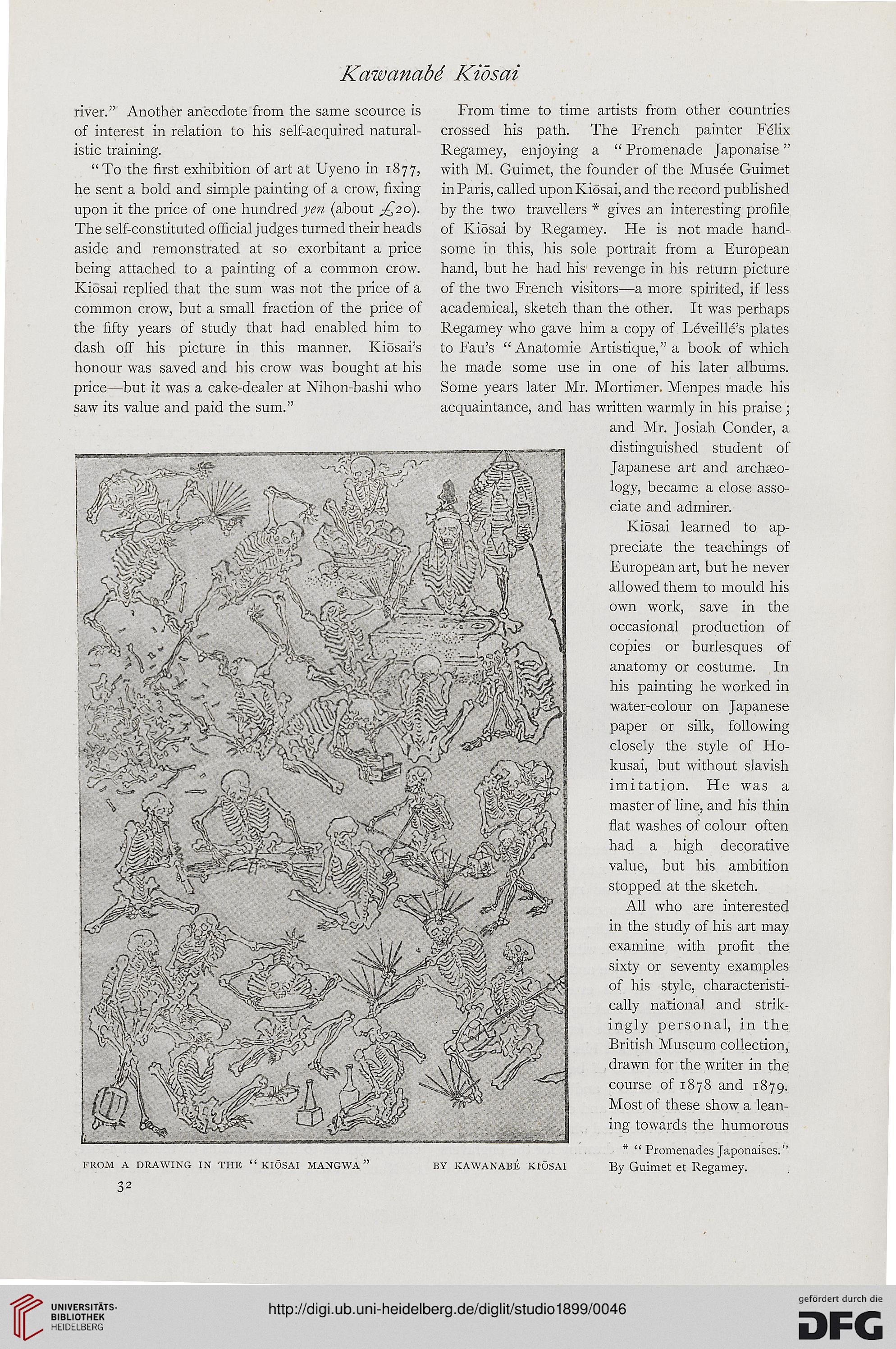Kawaimbd Kibsai
river." Another anecdote from the same scource is From time to time artists from other countries
of interest in relation to his self-acquired natural- crossed his path. The French painter Felix
istic training. Regamey, enjoying a " Promenade Japonaise"
"To the first exhibition of art at Uyeno in 1877, with M. Guimet, the founder of the Musee Guimet
he sent a bold and simple painting of a crow, fixing in Paris, called upon Kiosai, and the record published
upon it the price of one hundred yen (about £,20). by the two travellers * gives an interesting profile
The self-constituted official judges turned their heads of Kiosai by Regamey. He is not made hand-
aside and remonstrated at so exorbitant a price some in this, his sole portrait from a European
being attached to a painting of a common crow, hand, but he had his revenge in his return picture
Kiosai replied that the sum was not the price of a of the two French visitors—a more spirited, if less
common crow, but a small fraction of the price of academical, sketch than the other. It was perhaps
the fifty years of study that had enabled him to Regamey who gave him a copy of Leveille's plates
dash off his picture in this manner. Kiosai's to Fau's " Anatomie Artistique," a book of which
honour was saved and his crow was bought at his he made some use in one of his later albums,
price—but it was a cake-dealer at Nihon-bashi who Some years later Mr. Mortimer. Menpes made his
saw its value and paid the sum." acquaintance, and has written warmly in his praise;
and Mr. Josiah Conder, a
distinguished student of
Japanese art and archaeo-
logy, became a close asso-
ciate and admirer.
M ^j0^L>^{ •y%&£z Jf *$j@P$B&f >BgE=Zi&il\ ciace ana aamirer.
Ki5sai learned t0 ap
.v^SSQT" m^-v^5" ^A%5«5*eb r3f??$m}*Vu5*\ • preciate the teachings o:
J^^fiv\^^^T \ preciate the teachings of
C^^^^iC/^^lT^\ European art, but he never
M£ h Mm£k 1 A • aUowed them to mould his
S "f^*^^? \ occasional production of
copies or burlesques of
anatomy or costume. In
his painting he worked in
water-colour on Japanese
paper or silk, following
closely the style of Ho-
kusai, but without slavish
imitation. He was a
master of line, and his thin
flat washes of colour often
had a high decorative
value, but his ambition
stopped at the sketch.
All who are interested
in the study of his art may
examine with profit the
sixty or seventy examples
of his style, characteristi-
cally national and strik-
ingly personal, in the
British Museum collection,
drawn for the writer in the
course of 1878 and 1879.
Most of these show a lean-
ing towards the humorous
* " Promenades J aponaiscs."
from a drawing in the " kiosai mangwa " by kawanabe kiosai By Guimet et Regamey.
32
river." Another anecdote from the same scource is From time to time artists from other countries
of interest in relation to his self-acquired natural- crossed his path. The French painter Felix
istic training. Regamey, enjoying a " Promenade Japonaise"
"To the first exhibition of art at Uyeno in 1877, with M. Guimet, the founder of the Musee Guimet
he sent a bold and simple painting of a crow, fixing in Paris, called upon Kiosai, and the record published
upon it the price of one hundred yen (about £,20). by the two travellers * gives an interesting profile
The self-constituted official judges turned their heads of Kiosai by Regamey. He is not made hand-
aside and remonstrated at so exorbitant a price some in this, his sole portrait from a European
being attached to a painting of a common crow, hand, but he had his revenge in his return picture
Kiosai replied that the sum was not the price of a of the two French visitors—a more spirited, if less
common crow, but a small fraction of the price of academical, sketch than the other. It was perhaps
the fifty years of study that had enabled him to Regamey who gave him a copy of Leveille's plates
dash off his picture in this manner. Kiosai's to Fau's " Anatomie Artistique," a book of which
honour was saved and his crow was bought at his he made some use in one of his later albums,
price—but it was a cake-dealer at Nihon-bashi who Some years later Mr. Mortimer. Menpes made his
saw its value and paid the sum." acquaintance, and has written warmly in his praise;
and Mr. Josiah Conder, a
distinguished student of
Japanese art and archaeo-
logy, became a close asso-
ciate and admirer.
M ^j0^L>^{ •y%&£z Jf *$j@P$B&f >BgE=Zi&il\ ciace ana aamirer.
Ki5sai learned t0 ap
.v^SSQT" m^-v^5" ^A%5«5*eb r3f??$m}*Vu5*\ • preciate the teachings o:
J^^fiv\^^^T \ preciate the teachings of
C^^^^iC/^^lT^\ European art, but he never
M£ h Mm£k 1 A • aUowed them to mould his
S "f^*^^? \ occasional production of
copies or burlesques of
anatomy or costume. In
his painting he worked in
water-colour on Japanese
paper or silk, following
closely the style of Ho-
kusai, but without slavish
imitation. He was a
master of line, and his thin
flat washes of colour often
had a high decorative
value, but his ambition
stopped at the sketch.
All who are interested
in the study of his art may
examine with profit the
sixty or seventy examples
of his style, characteristi-
cally national and strik-
ingly personal, in the
British Museum collection,
drawn for the writer in the
course of 1878 and 1879.
Most of these show a lean-
ing towards the humorous
* " Promenades J aponaiscs."
from a drawing in the " kiosai mangwa " by kawanabe kiosai By Guimet et Regamey.
32




